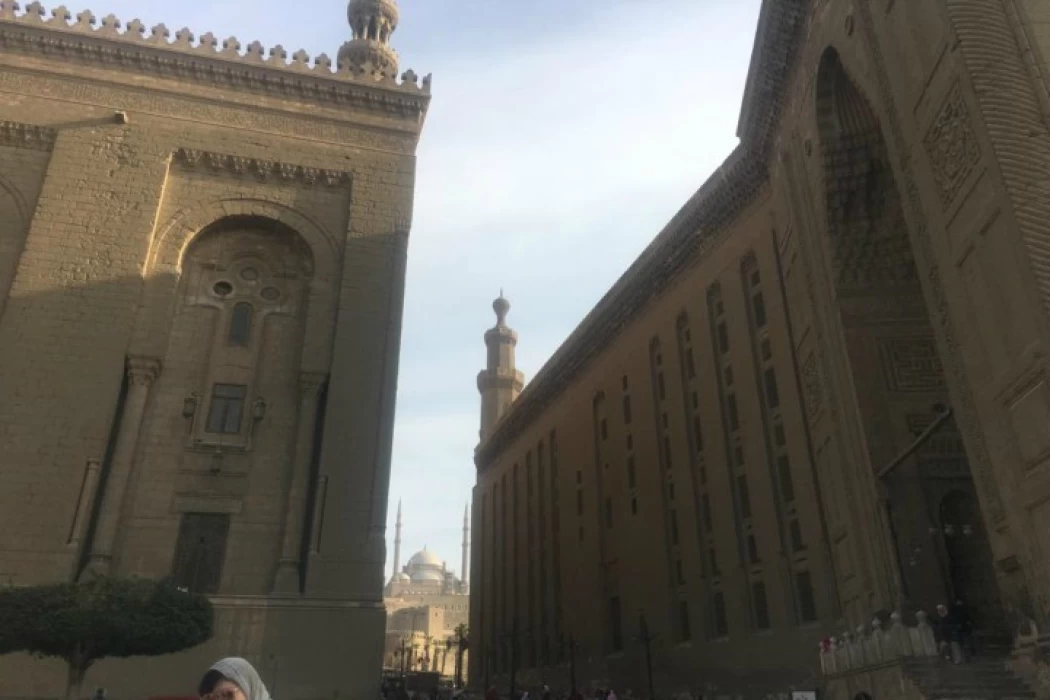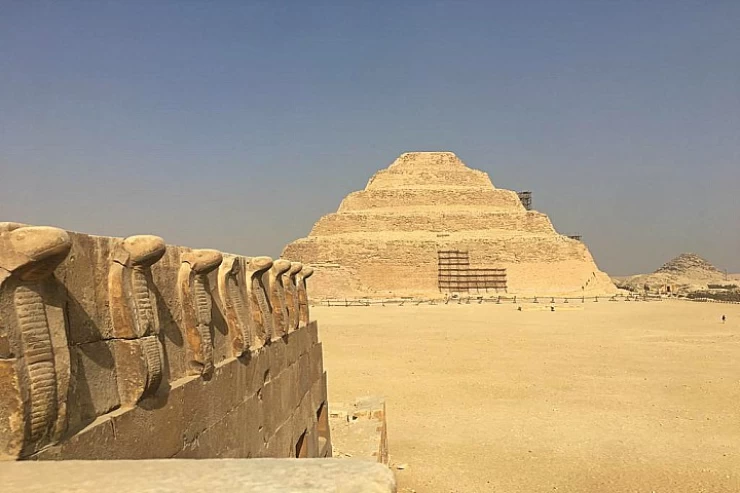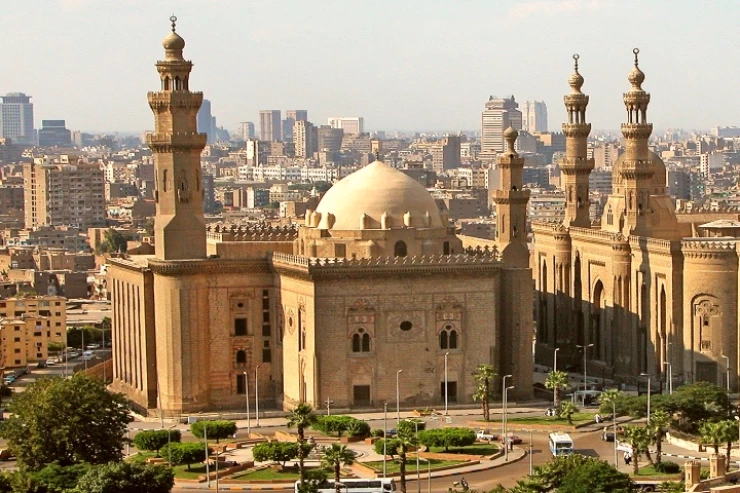
Complesso di Sultan Hassan
Il Complesso del Sultano Hassan
Uno dei belli complessi, Il Complesso del Sultano Hassan combinava la grandezza dell'edificio, l'accuratezza dell'industria e la diversità della decorazione, quindi meritava di essere descritto come un capolavoro architettonico e orgoglio dell'antica arte islamica. Si dice della monumentale moschea di "Gomar" in un libro che descrive l'Egitto: "È uno degli edifici più belli del Cairo e dell'Islam, per la sua alta cupola, l'altezza del suo minareto, l'osso della sua larghezza, il lusso e l'abbondanza della sua decorazione Al-Maqrizi lo descrisse come "uno dei templi musulmani non è conosciuto nell'Islam Questo imita la moschea. "
Il più grande edificio del Cairo islamico oltre alla porta più alta soprattutto tra tutte le moschee e le scuole. Il complesso è composto da moschea, scuola e pernottamento per studenti e insegnanti, ha quattro scuole per insegnare i quattro riti sunniti,
La Moschea del Sultano Hassan è considerata una delle moschee più complete da fare al Cairo o forse in tutto il mondo e specialmente nel Cairo islamico, misura 150 metri di lunghezza e copre un'area di 7.906 mq. Le sue mura raggiungono un'altezza di 36 metri e il suo minareto più alto è di 68 metri. I visitatori possono entrare nel complesso attraverso un alto portale che è un'opera d'arte eccezionale. Un passaggio scuro e dal soffitto relativamente basso conduce al brillante splendore, un cortile aperto a pianta cruciforme standard. I centri del cortile su una fontana per abluzioni a cupola, che era probabilmente un'aggiunta ottomana. Svettando su quattro lati del patio ci sono iwan rotondi (salotti), mantenuti da catene di lampade sospese e bordi rossi e neri. Il famoso sultano mamelucco Hassan che ha fondato (La moschea del sultano Hassan), è il figlio del grande sultano mamelucco Al-Nasser Mohamed Ibn Qalawoun " Moschea di Al-Nasser Mohammed Ibn Kalawoun ". Governò due regni interrotti, la prima volta nel 1347, quando aveva 13 anni, per essere detronizzato dagli altri principi e generali mamelucchi. La seconda volta fu nel 1356 d.C. e prima che avesse il tempo di porre fine al potere dei principi e degli alti funzionari, fecero una rivoluzione contro di lui. Si dice che sia fuggito dalla cittadella di Salah Eldin ma che sia stato trovato e imprigionato, per non essere mai più visto. Apparentemente è stato ucciso 16 anni dopo la sua ascensione al trono. Ha lasciato 10 figli e 6 figlie.
La moschea è stata costruita sul sistema delle scuole con pianificazione ortogonale, e ogni scuola è considerata una piccola moschea, e ciascuna di esse è dedicata all'insegnamento di una delle quattro scuole islamiche, "Shafi'i, Maliki, Hanbali e Hanafi", la più grande di queste scuole hanafi. Venti candidati e tre assistenti didattici, e a ciascuno di loro è stato assegnato uno stipendio in base al proprio lavoro. Ha nominato un insegnante per interpretare il Corano e con lui trenta studenti. Ha anche nominato un insegnante per la hadith del Profeta, e gli è stato assegnato uno stipendio di 300 dirham.
Come tipico nello stile di pianificazione dell'architettura mamelucca, il qibla iwan è il più grande dei 4 iwan all'interno della moschea, che è stato fatto di marmo e noto come la panchina del ripetitore, situato di fronte alla qibla iwan è (Dekkat Al-Mouballegh), sollevato sopra 8 pilastri e 3 pilastri. Dietro il mihrab, ci sono 2 porte aperte nel muro di Quibla che conducono a una cupola del mausoleo dove si dice che il Sultano sia sepolto. Il tetto del Mausoleo è di 21 metri quadrati e la sua decorazione è simile a quella della qibla iwan.
Vicino alla Moschea del Sultano Hassan si possono visitare: Moschea di Ibn Tulun ,La Cittadella di Salah El Din al Cairo, Moschea di Al Azhar ,sono veramente belle.
Il nostro team vi aiuterà a viaggiare in Egitto e sperimentare il tempo soleggiato del nostro bel paese durante tour di Pasqua in Egitto, grazie alla loro vasta conoscenza del turismo egiziano. Puoi dedicare il tuo pacchetto selezionando uno dei nostri pacchetti di viaggio in Egitto o sfruttare al massimo il tuo tempo in una breve visita, imparando di più sulla storia egiziana e le sue affascinanti storie e vivendola attraverso tour privati al Cairo. Partecipa a uno dei nostri tour economici in Egitto attraverso il deserto del Sahara, come i tour di Siwa dal Cairo, per esempio, o preferibilmente i tour nel Deserto Bianco d'Egitto. Scopri i nostri tour di un giorno ad Assuan, fate una gita di un giorno da Assuan ad Abu Simbel, o viaggerese via terra e vi godreste i nostri tour di un giorno a Luxor per vedere gli incredibili templi di Karnak, il Tempio di Luxor, il Tempio di Hatshepsut, e vedete le meravigliose tombe splendidamente dipinte nella Valle dei Re, questo è il luogo dove i re e i governanti del nuovo regno riposano in pace e imparate i loro riti di mummificazione e sepoltura.
Potete visitare tutti questi luoghi e monumenti attraverso i nostri pacchetti di vacanze o le escursioni giornalieri o anche le escursioni dai porti egiziani, dove i nostri rappresentanti vi accompagnano durante tutto il viaggio e durante tutta la escursione.
Possiamo insegnarvi a conoscere un luogo speciale in Egitto chiamato Lago Temsah o Lago dei Coccodrilli. Possiamo anche portarvi in tutti i luoghi più divertenti e interessanti.
The Mosque and Madrasa of Sultan Hassan is one of the most stunning examples of Islamic architecture in Cairo, and it is not surprising that the mosque is situated around the Citadel of Saladin, in the interior of Old Cairo. The complex embodies the epic proportions of Mamluk architecture and is famous for its great scale, beautiful intricate patterns and detail, and its past. Visitors around the globe make pilgrimages to the beauty and history of this architectural and cultural masterpiece, which is the pride of the Mamluk Sultanate.
Historical Overview
This mosque and khanqah compound construction was commissioned by Sultan Hassan bin al-Nasir Muhammad around the year 1356 AD, and he intended it to be more than a mosque as it would serve as a madrasa (school of study) for the four major Sunni sects of Islam: Hanafi, Maliki, Shafi’i, and Hanbali. The construction of the tomb was commenced in the 1356 Christian era, which took around seven years to complete. It was also used as a place to learn and worship. But the bad part was that, alas, within a matter of hours, after the Sultan ordered his last and grandest design, the Sultan was assassinated, thus enhancing the myth.
The complex was built in one of the cities that over the years have suffered many interruptions within its history, internally due to earthquakes as well as military sieges, some of which rendered its architectural design adversely. But it has remained a significant symbol of Mamluk rule and devotion and continues to be open for worship and visitors.
While the Sultan Hassan Complex has much to offer, its enormous scale is undoubtedly the most impressive feature. The main entry that is just under 26 meters in height leads to a courtyard that is surrounded by walls that rise to a height of 36 meters. The entire mosque covered about 7900 square meters, making it one of the biggest mosques in the globe. The building’s symmetrical stone elevation and rich use of geometrical decor and ornamental monuments are typical Mamluk architectural designs.
Also, within the mosque’s interior—except for the one iwab—which houses four schools of Sunni Islam and a large central courtyard, which is encircled by four iwans. The Iwan located at the center pointing to Mecca is enhanced with elaborate stucco work and marbles, as well as a decorated'mihrab.'.’ The courtyard is also properly arranged with the help of vertical members in the form of columns. The guests will also admire the lofty walls of the space, which have curved ceilings, creating an almost ethereal feeling in the room.
The organization, which is popularly referred to as the madrasa or Islamic institution in its primary sense, was one of the objects of the original vision of the complex. So all four iwans also served as classrooms for one of the Sunni judicial schools. This period also explains the presence of such illustrious personages in the inner chambers surrounded by students hailing from every corner of the Muslim world due to its esteem as the pinnacle of education.
The institution committed to the good health of its students as well. This implied that in addition to regular classes being offered, nutrition, dormitories, and a reading room were also provided to the students. The madrasah is covered by Koranic verses placed on the walls as ornaments and motivational resources for the student scholars who were within its confines.
Equally intriguing is the tomb of Sultan Hassan, which is another distinguishing element of the Sultan Hassan Complex. The tomb is in the back of the main prayer room and is said to be one of the best preserved examples of Mumluk burial architecture. The dome is surmounted by a giant dome that is 21 meters in height and is embellished with beautiful arabesques and inscriptions. Based within the mausoleum, there lies the sarcophagus of Sultan Hassan, encased in walls of marble embedded with Mamluk-style masterpieces.
Interestingly, Sultan Hassan’s body was never interred in this mausoleum, as he was killed before the complex was completed, and his remains were buried elsewhere. Nevertheless, the mausoleum remains a symbolic resting place and is a beautiful tribute to his memory.
The Sultan Hassan Complex is a superlative work of Islamic art and architecture, with every detail thoughtfully designed and executed to fit the Mamluk style. The walls and ceilings are clad in arabesques, geometric designs, calligraphy, and other typical components of Islamic art. The fishtail and stucco carving works, embellished on the surfaces, unequivocally demonstrate the exceptional artistry that went into building the entire complex.
Among the dominant artistic aspects, one cannot miss the beautiful wooden mashrabiya, which has elaborate floral and geometric carvings in it, encouraging the eye to explore its design. In addition to enhancing the beauty of the complex, these screens also provide ventilation as well as privacy. Another thing that adds beauty to the mosque is its mihrab, which is made of marble and embellished with decorative panels and mosaics that instill a certain level of spirituality.


















